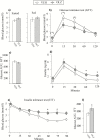One-Year Treatment with Olanzapine Depot in Female Rats: Metabolic Effects
- PMID: 30854556
- PMCID: PMC6499254
- DOI: 10.1093/ijnp/pyz012
One-Year Treatment with Olanzapine Depot in Female Rats: Metabolic Effects
Abstract
Background: Antipsychotic drugs can negatively affect the metabolic status of patients, with olanzapine as one of the most potent drugs. While patients are often medicated for long time periods, experiments in rats typically run for 1 to 12 weeks, showing olanzapine-related weight gain and increased plasma lipid levels, with transcriptional upregulation of lipogenic genes in liver and adipose tissue. It remains unknown whether metabolic status will deteriorate with time.
Methods: To examine long-term metabolic effects, we administered intramuscular long-acting injections of olanzapine (100 mg/kg BW) or control substance to female rats for up to 13 months.
Results: Exposure to olanzapine long-acting injections led to rapid weight gain, which was sustained throughout the experiment. At 1, 6, and 13 months, plasma lipid levels were measured in separate cohorts of rats, displaying no increase. Hepatic transcription of lipid-related genes was transiently upregulated at 1 month. Glucose and insulin tolerance tests indicated insulin resistance in olanzapine-treated rats after 12 months.
Conclusion: Our data show that the continuous increase in body weight in response to long-term olanzapine exposure was accompanied by surprisingly few concomitant changes in plasma lipids and lipogenic gene expression, suggesting that adaptive mechanisms are involved to reduce long-term metabolic adverse effects of this antipsychotic agent in rats.
Keywords: diabetes; long-term; olanzapine; rat; weight gain.
© The Author(s) 2019. Published by Oxford University Press on behalf of CINP.
Figures






Similar articles
-
Lipid-lowering effects of tetradecylthioacetic acid in antipsychotic-exposed, female rats: challenges with long-term treatment.PLoS One. 2012;7(11):e50853. doi: 10.1371/journal.pone.0050853. Epub 2012 Nov 30. PLoS One. 2012. PMID: 23226405 Free PMC article.
-
Olanzapine depot formulation in rat: a step forward in modelling antipsychotic-induced metabolic adverse effects.Int J Neuropsychopharmacol. 2014 Jan;17(1):91-104. doi: 10.1017/S1461145713000862. Epub 2013 Aug 7. Int J Neuropsychopharmacol. 2014. PMID: 23919889
-
Olanzapine depot exposure in male rats: Dose-dependent lipogenic effects without concomitant weight gain.Eur Neuropsychopharmacol. 2015 Jun;25(6):923-32. doi: 10.1016/j.euroneuro.2015.03.002. Epub 2015 Mar 18. Eur Neuropsychopharmacol. 2015. PMID: 25823694
-
Olanzapine-induced weight gain: chronic infusion using osmotic minipumps does not result in stable plasma levels due to degradation of olanzapine in solution.Eur J Pharmacol. 2008 May 6;585(1):130-6. doi: 10.1016/j.ejphar.2007.11.078. Epub 2008 Mar 4. Eur J Pharmacol. 2008. PMID: 18378227 Review.
-
Obesity and related metabolic abnormalities during antipsychotic drug administration: mechanisms, management and research perspectives.Pharmacopsychiatry. 2002 Nov;35(6):205-19. doi: 10.1055/s-2002-36391. Pharmacopsychiatry. 2002. PMID: 12518268 Review.
Cited by
-
Combination of Olanzapine Pamoate with Melatonin and Metformin: Quantitative Changes in Rat Adipose Tissue.Curr Health Sci J. 2019 Oct-Dec;45(4):372-382. doi: 10.12865/CHSJ.45.04.05. Epub 2019 Dec 30. Curr Health Sci J. 2019. PMID: 32110439 Free PMC article.
-
Housing Temperature Influences Atypical Antipsychotic Drug-Induced Bone Loss in Female C57BL/6J Mice.JBMR Plus. 2021 Sep 7;5(10):e10541. doi: 10.1002/jbm4.10541. eCollection 2021 Oct. JBMR Plus. 2021. PMID: 34693191 Free PMC article.
-
Zinc Sulfate Alleviates Olanzapine Induced Alteration in Hepatic Protein Patterns and Antioxidant Defense System in Rats.Biol Trace Elem Res. 2025 May 30. doi: 10.1007/s12011-025-04673-3. Online ahead of print. Biol Trace Elem Res. 2025. PMID: 40442458
-
Preclinical and Clinical Sex Differences in Antipsychotic-Induced Metabolic Disturbances: A Narrative Review of Adiposity and Glucose Metabolism.J Psychiatr Brain Sci. 2019;4:e190013. doi: 10.20900/jpbs.20190013. Epub 2019 Aug 29. J Psychiatr Brain Sci. 2019. PMID: 31555747 Free PMC article.
-
Olanzapine, but not haloperidol, exerts pronounced acute metabolic effects in the methylazoxymethanol rat model.CNS Neurosci Ther. 2024 Feb;30(2):e14565. doi: 10.1111/cns.14565. CNS Neurosci Ther. 2024. PMID: 38421095 Free PMC article.
References
-
- Aleixandre de Artinano A, Miguel Castro M (2009) Experimental rat models to study the metabolic syndrome. Br J Nutr 102:1246–1253. - PubMed
-
- Aravagiri M, Teper Y, Marder SR (1999) Pharmacokinetics and tissue distribution of olanzapine in rats. Biopharm Drug Dispos 20:369–377. - PubMed
-
- Benarroch L, Kowalchuk C, Wilson V, Teo C, Guenette M, Chintoh A, Nesarajah Y, Taylor V, Selby P, Fletcher P, Remington GJ, Hahn MK (2016) Atypical antipsychotics and effects on feeding: from mice to men. Psychopharmacology (Berl) 233:2629–2653. - PubMed
Publication types
MeSH terms
Substances
LinkOut - more resources
Full Text Sources

